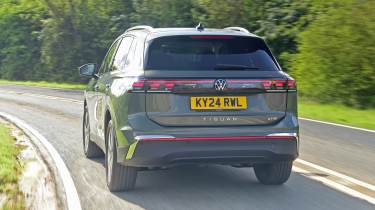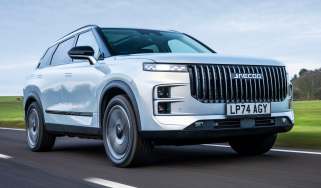Volkswagen Tiguan review - MPG, running costs & CO2 emissions
“From launch, the Tiguan’s engine options are fairly conventional, though plug-in hybrids will arrive later”
The Volkswagen Tiguan launched with a fairly straightforward set of engine options: a 1.5-litre mild-hybrid petrol with a choice of two power outputs and a 2.0-litre diesel. A plug-in hybrid eHybrid model with a 1.5-litre engine and electric motor was later added to the lineup in two power outputs, the higher of which is offered exclusively on R-Line trim. The PHEVs offer an impressive electric range of up to 77 miles, meaning you get the benefit of quiet, smooth driving for long periods of time.
Without doubt the PHEVs have the biggest potential for frugal fuel-economy figures, with the 201bhp version capable of up to an official 707mpg, while the 268bhp R-Line version gets up to 673mpg. Be aware that those lofty figures are only remotely achievable if you keep the Tiguan eHybrid regularly charged up and do as little petrol-powered driving as possible.
Rock-bottom CO2 emissions of 9g/km (or 10g/km for the more powerful R-Line) make the PHEVs the company cars of choice given their low BiK (Benefit-in-Kind) tax ratings.
In August 2024, Volkswagen also announced the introduction of a hot 2.0-litre TSI petrol engine and 4Motion all-wheel drive for R-Line models. The brand is yet to release official fuel economy and CO2 emissions stats for this version, but with no mild-hybrid assistance and fuel-sapping four-wheel drive, expect it to be one of the worst in terms of fuel efficiency.
The 1.5-litre petrol engines – badged eTSI – are turbocharged and mild-hybrid assisted, so they’re reasonably efficient for a car this size, though drivers that regularly cover long distances on the motorway will be best served by the TDI diesel.
More reviews
Pick either 1.5-litre petrol and it will return mid-40s mpg – the difference is fairly marginal, so if you really want the 20bhp of extra grunt there’s little compromise, especially given that lower mpg figure is also down to the higher-output engine only being available on the heavier ‘Life’ trim level and above, rather than the base model.
The 2.0-litre TDI diesel can return up to 52.5mpg with emissions of 141g/km. While this is more impressive than the petrol models, it’s important to note that it’s best suited to those doing regular motorway drives rather than for short journeys about town. Efficiency for the diesel has actually dropped in comparison to its application the old Tiguan, however, so it emits roughly 3g/km more carbon dioxide and has lower mpg.
Those emissions figures mean no version of the Tiguan sits in a particularly favourable BiK (Benefit-in-Kind), so company-car buyers will be better off with a rival plug-in hybrid or electric model such as the Volkswagen ID.4 thanks to their low emissions putting them into lower bands. If you can wait and want to buy a Tiguan as a company car, you’re best holding out for the plug-in models.
|
Model |
Fuel economy |
CO2 emissions |
|
1.5-litre eTSI 128bhp |
46.3mpg |
140g/km |
|
1.5-litre eTSI 148bhp |
45.6mpg |
141g/km |
| 2.0-litre TSI 201bhp | TBC | TBC |
|
2.0-litre TDI 148bhp |
52.5mpg |
141g/km |
| 1.5-litre eHybrid 201bhp | 707mpg | 9g/km |
| 1.5-litre eHybrid 268bhp | 673mpg | 10g/km |
How efficient is the Volkswagen Tiguan in the real world?
We tested a 2.0-litre TDI diesel model in Elegance trim, with an official fuel economy figure of 49.9mpg – we found by our real-world calculations that we were achieving figures around the low 40s.
What will the Volkswagen Tiguan cost to insure?
We’re yet to get official insurance figures for the Volkswagen Tiguan, although the outgoing model sat between a wide range from group 15 to 36. We expect something similar for this new model, and perhaps with the discontinuation of the hot Tiguan R model the maximum group will be lower.

















